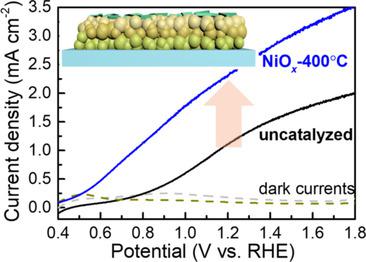当前位置:
X-MOL 学术
›
ChemSusChem
›
论文详情
Our official English website, www.x-mol.net, welcomes your
feedback! (Note: you will need to create a separate account there.)
Understanding the Roles of NiOx in Enhancing the Photoelectrochemical Performance of BiVO4 Photoanodes for Solar Water Splitting
ChemSusChem ( IF 7.5 ) Pub Date : 2018-10-23 , DOI: 10.1002/cssc.201801780
Mengyuan Zhang 1 , Rajini P. Antony 1, 2 , Sing Yang Chiam 3 , Fatwa Firdaus Abdi 4 , Lydia Helena Wong 1
ChemSusChem ( IF 7.5 ) Pub Date : 2018-10-23 , DOI: 10.1002/cssc.201801780
Mengyuan Zhang 1 , Rajini P. Antony 1, 2 , Sing Yang Chiam 3 , Fatwa Firdaus Abdi 4 , Lydia Helena Wong 1
Affiliation

|
Solar water oxidation is considered as a promising method for efficient utilization of solar energy and bismuth vanadate (BiVO4) is a potential photoanode. Catalyst loading on BiVO4 is often used to tackle the limitations of charge recombination and sluggish kinetics. In this study, amorphous nickel oxide (NiOx) is loaded onto Mo‐doped BiVO4 by photochemical metal–organic deposition method. The resulting NiOx/Mo:BiVO4 photoanodes demonstrate a two‐fold improvement in photocurrent density (2.44 mA cm−2) at 1.23 V versus reversible hydrogen electrode (RHE) compared with the uncatalyzed samples. After NiOx modification the charge‐separation and charge‐transfer efficiencies improve significantly across the entire potential range. It is further elucidated by open‐circuit photovoltage (OCP), time‐resolved‐microwave conductivity (TRMC), and rapid‐scan voltammetry (RSV) measurements that NiOx modification induces larger band bending and promotes efficient charge transfer on the surface of BiVO4. This work provides insight into designing BiVO4‐catalyst assemblies by using a simple surface‐modification route for efficient solar water oxidation.
中文翻译:

了解NiOx在增强BiVO4光电阳极用于太阳能水分解的光电化学性能中的作用
太阳能氧化被认为是有效利用太阳能的一种有前途的方法,而钒酸铋(BiVO 4)是一种潜在的光电阳极。BiVO 4上的催化剂负载量通常用于解决电荷重组和缓慢动力学的局限性。在这项研究中,通过光化学金属有机沉积法将非晶态氧化镍(NiO x)负载到Mo掺杂的BiVO 4上。与未催化的样品相比,所得的NiO x / Mo:BiVO 4光电阳极与可逆氢电极(RHE)相比在1.23 V的光电流密度(2.44 mA cm -2)提高了两倍。NiO x之后修改后,整个电位范围内的电荷分离效率和电荷转移效率均得到显着提高。开路光电压(OCP),时间分辨微波电导率(TRMC)和快速扫描伏安法(RSV)测量进一步阐明了NiO x改性引起更大的能带弯曲并促进BiVO表面上有效的电荷转移4。这项工作通过使用简单的表面改性路线来有效地氧化太阳能,从而为设计BiVO 4催化剂组件提供了见识。
更新日期:2018-10-23
中文翻译:

了解NiOx在增强BiVO4光电阳极用于太阳能水分解的光电化学性能中的作用
太阳能氧化被认为是有效利用太阳能的一种有前途的方法,而钒酸铋(BiVO 4)是一种潜在的光电阳极。BiVO 4上的催化剂负载量通常用于解决电荷重组和缓慢动力学的局限性。在这项研究中,通过光化学金属有机沉积法将非晶态氧化镍(NiO x)负载到Mo掺杂的BiVO 4上。与未催化的样品相比,所得的NiO x / Mo:BiVO 4光电阳极与可逆氢电极(RHE)相比在1.23 V的光电流密度(2.44 mA cm -2)提高了两倍。NiO x之后修改后,整个电位范围内的电荷分离效率和电荷转移效率均得到显着提高。开路光电压(OCP),时间分辨微波电导率(TRMC)和快速扫描伏安法(RSV)测量进一步阐明了NiO x改性引起更大的能带弯曲并促进BiVO表面上有效的电荷转移4。这项工作通过使用简单的表面改性路线来有效地氧化太阳能,从而为设计BiVO 4催化剂组件提供了见识。































 京公网安备 11010802027423号
京公网安备 11010802027423号